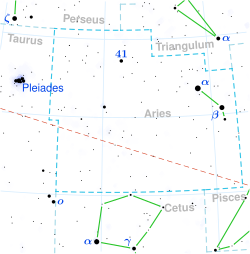Top Qs
Timeline
Chat
Perspective
Theta Arietis
Binary star system in the constellation Aries From Wikipedia, the free encyclopedia
Remove ads
Theta Arietis, is a binary star[7] system in the northern constellation of Aries. Its name is a Bayer designation that is Latinised from θ Arietis, and abbreviated Theta Ari or θ Ari. This star is faintly visible to the naked eye with an apparent visual magnitude of 5.58.[3] With an annual parallax shift of 7.22 mas,[2] the distance to this star is an estimated 452 light-years (139 parsecs) with a 7-light-year margin of error. It is drifting further away from the Sun with a radial velocity of +12 km/s.[2]
The primary, component A, is a white-hued, A-type main-sequence star with a stellar classification of A1 Vn.[4] It is spinning at a rapid pace as shown by the projected rotational velocity of 186 km/s.[10] This is causing the "nebulous" appearance of the absorption lines indicated by the 'n' suffix in the classification. In 2005, C. Neiner and associates classified this as a Be star because is displays emission features in the hydrogen Balmer lines.[6]
In 2016, a solar-mass companion was reported in close orbit around this star, based on observations using adaptive optics with the Gemini North Telescope.[7]
Remove ads
References
External links
Wikiwand - on
Seamless Wikipedia browsing. On steroids.
Remove ads

